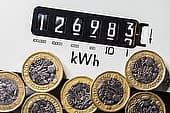Home > Energy > News > Ofgem propose £21 price cap allowance for bad debt
Ofgem propose £21 price cap allowance for bad debt
Regulator is consulting on the possibility of adding an extra £21 to the default tariff price cap from April 2021.
If the proposals go ahead, an allowance of £21 will be factored into the new cap when it comes into force next year.
Ofgem are concerned Covid-19 customer debt will create additional costs for energy companies that should be addressed through the cap.
Thanks to the different methodology used to calculate the cap for prepayment meter customers, there won't be an allowance added to that price cap.

Higher bills
It's important to understand the £21 Ofgem are consulting on is not the level the cap will rise in April - it's an extra allowance that would be added no matter what the default price cap is set at.
So, it would add an extra £21 to the bills of all customers on standard variable tariffs (SVTs), providing a buffer for the energy industry as bad debt affects the sector.
The latest default tariff price cap was set at £1,042 per year for the period from 1 October 2020 to 31 March 2021, the lowest level since the cap was first introduced in January 2019.
Yet Ofgem already hinted the next version of the cap would take account of coronavirus aftershocks, and these proposals confirm exactly how much they expect that extra allowance to be.
Bad debt
The energy industry expects more customers to struggle with their bills in the coming months as the economy struggles in the wake of the coronavirus crisis.
Ofgem point out these problems could increase over the winter months as customers use more energy and potentially fall further behind on their bills.
Although the full impact of bad debt takes a while to pass through the system, Ofgem recognises that customers missing bills has an immediate effect on the cash flow of a supplier.
So, they are setting the £21 adjustment now as an estimate of debt-related costs, and they will amend it in the future when the actual costs of coronavirus debt on the energy sector is made clear.
This means bills could rise further in the future if Ofgem judge the cap estimate was too low and suppliers are out of pocket from coronavirus debt.
Default price cap
The default price cap is set twice a year, and mainly reflects the fluctuating prices of energy on the wholesale market, meaning suppliers are forced to lower their SVT rates if wholesale prices fall.
Thanks to the coronavirus outbreak, wholesale prices fell dramatically in middle of 2020 as fewer businesses were using fuel.
This was reflected in the £84 reduction in the cap when it was set for October 2020 to March 2021, despite energy suppliers encouraging Ofgem to consider the impact of bad debt when setting that cap level.
Instead, the financial consequences of coronavirus will be felt on bills from April 2021 to September 2021, and Ofgem haven't ruled out further adjustments due to coronavirus from October 2021 onwards.
It's important to remember most households could benefit from switching to a cheap fixed tariff rather than staying on a variable tariff.
Although fixed tariff prices are likely to rise in line with wholesale energy costs and other factors, finding the best energy deal for your household now could save money as bills begin to creep up again.
Learn more about fixed energy plans or find out how to read your energy bill to check which tariff you're currently on.
Get insider tips and the latest offers in our newsletter

We are independent of all of the products and services we compare.

We order our comparison tables by price or feature and never by referral revenue.

We donate at least 5% of our profits to charity, and we have a climate positive workforce.
Latest News

02 January 2024
Energy prices increase by 5%
23 November 2023
Energy price cap to rise 5% in January 2024
24 October 2023
Energy companies must do more to support customersGet insider tips and the latest offers in our newsletter


